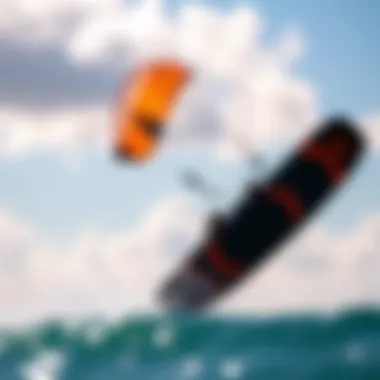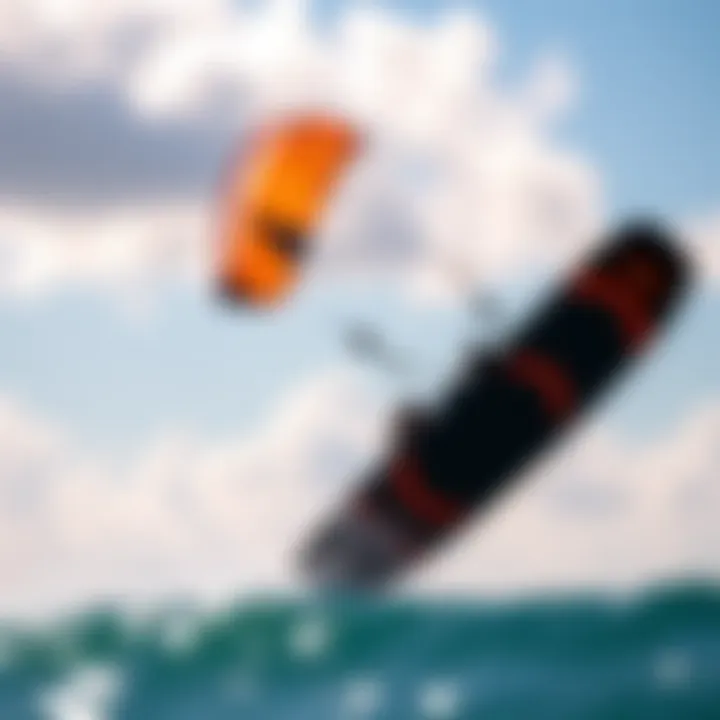Best Kiteboarding Kites for Beginners: A Complete Guide


Intro
Kiteboarding is an exhilarating sport that draws countless fans toward the water’s edge. The thrill of harnessing the wind to propel oneself across waves is something that can’t be easily expressed in mere words. For novices, the first steps in this world can often feel like standing at the base of a steep mountain. Understanding what kites to use, how to gear up properly, and the basic techniques to master proves essential for fostering confidence and safety.
Choosing the right kiteboarding kite is akin to selecting the perfect bicycle as a child. Each kite differs not just in color but in wind designs, size, and handling. There are also various aspects of kite materials to keep in mind; each contributes uniquely to performance. This guide aims to demystify the kite selection process for beginners while ensuring safety and ease in learning.
Gear and Equipment
The excitement of kiteboarding should not overshadow the importance of suitable gear. Getting outfitted with the right equipment can mean the difference between enjoying a day on the water and feeling overwhelmed.
Essential Kiteboarding Gear for Beginners
To start kiteboarding, there’s a short list of must-have gear that novices should have:
- Kite: The most critical piece of equipment. Most beginners benefit from a beginner-friendly kite, specifically designed for stability and ease of control. Look into brands like Naish or Cabrinha for quality options.
- Control Bar and Lines: These pieces allow the rider to steer the kite. They should match the kite’s size and type.
- Harness: A good harness holds the kite’s power, allowing the rider to fly more comfortably.
- Board: Kiteboarding boards come in a range of shapes and sizes. Beginners often find it easier to start with a larger, more stable board.
- Safety Gear: Helmets and impact vests offer vital protection while learning.
“Choosing the right gear is like finding the perfect fit of your shoes; comfort and compatibility matter to ensure you step into the right ride.”
Advanced Equipment for Experienced Riders
As skills improve, kiteboarders may want to upgrade their equipment. Experienced riders might opt for performance kites that offer higher speeds and responsive steering. They might consider:
- Surf Kites: These are suitable for riding waves.
- Foil Kites: These can fly in lighter winds, allowing for maximum enjoyment in varied conditions.
- Directional Boards: These are designed for wave riding and offer different styles compared to twin-tips.
Techniques and Tips
Once equipped, a beginner’s journey doesn’t end with gear acquisition; mastering essential techniques is a must.
Basic Riding Techniques for Newbies
Learning to control the kite, balance, and ride can be broken down into steps:
- Understand Wind Patterns: Spend time observing how wind affects the kite. First, practice flying your kite on the land before heading to water.
- Body Positioning: Keeping an upright position while maintaining a relaxed stance can significantly improve balance.
- Start with a Lesson: Attending a local kiting school or hiring an instructor ensures that beginners learn proper techniques safely.
Expert Tricks to Elevate Your Skills
Once comfort with the basics is achieved, beginners may wish to explore more challenging maneuvers:
- Jumping: Start small by getting a feel for the reaction of the kite.
- Turns and Transitions: Practicing deeper turns enhances control and maneuverability.
- Riding in Waves: Eventually, learning to successfully navigate through waves can elevate the entire experience of kiteboarding.
Kiteboarding is not just about the adventure; it is about learning, growing, and enjoying the ride while remaining safe. The right gear, alongside practiced techniques, makes for a fulfilling journey into the waves. As you embark on this new hobby, always remember that patience and practice are key elements to mastering the art of kiteboarding.
For further information and resources on kiteboarding, you may find helpful insights at Kiteboarding USA and Kiteforum.
Understanding Kiteboarding Basics
Kiteboarding, an exhilarating combination of surfing, wakeboarding, and flying, transcends mere sport. For beginners, grasping the fundamentals is crucial for safety and enjoyment in this engaging water activity. To embark on this journey, one must first unravel the basic concepts, terminology, and components that define kiteboarding. Understanding these essentials lays a solid groundwork, streamlining the learning curve for newcomers and enhancing their overall experience.
What is Kiteboarding?
Kiteboarding, often referred to as kitesurfing, is a water sport that involves riding on a board while being propelled by a large, inflatable kite. The kite catches the wind and harnesses its power, allowing the rider to glide over water at high speeds, perform jumps, and execute tricks. The thrill of kiteboarding lies in its unique blend of adrenaline, skill, and harmony with nature.
This sport can be practiced in various locations, from tranquil lakes to open oceans, making it a versatile choice for outdoor enthusiasts. Kiteboarding not only challenges physical abilities but also promotes mental strength, as riders learn to read the wind and adapt to changing conditions.
Key Components of Kiteboarding
The essence of kiteboarding hinges on four primary components: the kite, board, control bar, and safety system. Each element plays a pivotal role in ensuring that a rider is equipped for both success and safety while navigating the waves.
Kite
The kite is the heart of kiteboarding. These large fabric structures harness the wind, translating it into the power needed to move across water. Beginner kites typically prioritize stability and ease of use. A notable characteristic of beginner kites is their larger size, which allows them to capture more wind and provides a more forgiving ride.
Unique feature: For instance, many beginner kites feature a delta shape, enhancing lift and stability. This design is beneficial as it reduces the likelihood of getting caught in tricky situations while learning, giving novices the confidence to progress.
Board
The board is what the rider stands on. Boards come in various shapes and sizes, tailored to different riding styles and skill levels. For beginners, a wider board with ample surface area offers greater stability and easier balance.


Key characteristic: A notable point about beginner boards is their softer flex, making them more forgiving over choppy water. This feature helps beginners maintain control as they get accustomed to the motion and feel of riding.
Control Bar
The control bar acts as the interface between the rider and the kite, allowing the kite to be steered and controlled. For beginners, it's crucial to have a control bar that offers comfort and ease of use. Most beginner bars come with color-coded lines and a simplified design, making it easier to manage.
Unique advantage: Many bars also include adjustable lengths, allowing for customization based on individual preferences. This adaptability enhances the learning experience, as it enables riders to find a comfortable set-up that aligns with their skill development.
Safety System
Safety systems are paramount, especially for those just starting their kiteboarding journey. These systems include quick-release mechanisms and leash setups that allow the rider to detach from the kite in emergencies. A well-designed safety system ensures that any potential mishaps can be managed swiftly, minimizing risks involved in the sport.
Key characteristic: The typical safety feature in beginner kites is a single-line release, which simplifies the process of depowering the kite. This design not only boosts confidence in learning but is also critical for maintaining control in strong winds or tricky situations.
By dissecting these components, beginners can better appreciate the intricate dynamics of kiteboarding. Knowledge on what makes kites suitable for new riders, and how these elements interact, paves the way for informed decisions when it comes to equipment selection. As one dives deeper into the sport, the understanding of these basics will serve as a valuable reference point.
The Importance of Kite Selection for Beginners
Choosing the right kite is more than just a matter of preference; it's a foundational step that can shape the entire kiteboarding experience for a newcomer. A well-chosen kite can provide a smooth introduction to the sport, boosting confidence while minimizing the risk of accidents or frustration. By considering factors like size, type, and design, beginners can align their kite choice with their anticipated conditions, personal preferences, and learning objectives.
When stepping into the world of kiteboarding, the significance of this selection cannot be overstated. Selecting a kite with characteristics suited for novices offers various benefits, including safety, ease of use, and the assurance that participants can focus on building foundational skills without getting overwhelmed or discouraged.
Why Choosing the Right Kite Matters
The right kite isn’t just a piece of equipment; it can be likened to a dependable companion on this adventure. A beginner kite is typically designed to be forgiving and stable. It’s engineered to withstand the unexpected gusts of wind that can throw novices off balance. An ill-suited kite can lead to mishaps, creating an intimidating experience that might lead some to abandon the sport.
A well-chosen kite enhances a beginner's ability to learn faster, fostering a more enjoyable atmosphere on the water.
Key Reasons for Proper Kite Selection:
- Safety: Kites designed for learners often include safety features and are less reactive to wind conditions.
- User-Friendly: Easy setup and straightforward control systems mean less time fiddling and more time riding.
- Progression: Kites suited for beginners help build skills effectively, paving the way for smoother transitions to advanced styles and techniques.
By making an informed decision, newbies set themselves up for success, minimizing the likelihood of mishaps and maximizing the overall enjoyment—an often overlooked benefit but crucial in the long run.
Matching Kites to Skill Level
Once the importance of kite selection is clear, the next step involves understanding how to match kites to one’s skill level. Not all kites are created equal, and identifying a kite that aligns with a beginner’s abilities is essential. When choosing, consider not just the current skill set, but also the progression trajectory.
For those still on the fence, it can be helpful to categorize kites based on experience. Here are a few classifications:
- Beginners: These are usually larger in size, providing great lift and stability, making them ideal in various conditions.
- Intermediate Kites: These are a bit more forgiving than advanced kites but require some comfort underfoot as they respond quicker to input from the rider.
- Advanced Kites: These kites can be more challenging to handle, often for those who have built up a solid foundation of skills.
It’s also wise to consult with local instructors or experienced kiteboarders, as they can offer insights based on specific changing conditions and personal preference.
"The right kite can make all the difference; it can turn a nerve-racking experience into an exhilarating one, keeping the thrill alive while ensuring safety."
As a beginner, knowing your current skill level and how it translates into kite selection will contribute to longer, more enjoyable sessions on the water. Remember, the ultimate goal is to learn at your own pace and develop skills that will lead to long-term enjoyment in kiteboarding.
Types of Kites Suitable for Beginners
Choosing the right type of kite is critical for newcomers to kiteboarding. The type of kite you select plays a huge role in how quickly and effectively you can learn the sport. Beginners need kites that not only match their skill level but also offer a forgiving ride and reliable performance. It’s like picking a partner for your first dance; you want someone who knows the steps and won’t step on your toes. In this section, we’ll explore two primary types of kites that are suited for novices: Foil Kites and Leading Edge Inflatable (LEI) Kites.
Foil Kites
Foil kites are quite the intriguing option for beginners. These kites do not have an inflatable structure but instead rely on the shape and design of the fabric to catch the wind. There are several advantages to this style of kite. For one, foil kites are typically lighter and more compact than LEI kites, making them easier to transport. When it comes to performance, they tend to deliver a smooth, steady pull due to their design that allows air to flow through them, making it less likely to experience sudden drops in power.
Benefits of Foil Kites:
- Weight and Portability: Lighter than their inflatable counterparts, they can be easily packed in a backpack.
- Stable Lift: They provide a consistent pull which can be quite comforting for those just starting out.
- Simple Rigging: Usually, they require less time to set up, so you can spend more time riding the waves than fiddling with gear.
However, it’s important to note that foil kites can be less forgiving in strong winds. They may require a more finesse approach to control. It’s advisable for beginners to start with medium wind conditions before tackling gusty days. Also, some finding it challenging to relaunch a foil kite when it lands on the water, a good practice with an instructor can mitigate this issue.
Leading Edge Inflatable (LEI) Kites
LEI kites are often the go-to for many beginners and for good reason. These kites are characterized by their inflatable leading edge, which provides structure and stability. When you pump them up, they become rigid, allowing for improved performance in a variety of wind conditions. LEIs are renowned for their ease of use; they are typically more forgiving in rough waters and can easily relaunch from the water, making them almost a comfort blanket for neophytes.
Characteristics of Leading Edge Inflatable Kites:


- Reliability in Variable Winds: They offer a stable and predictable ride, which is crucial for beginners getting to grips with control and balance.
- User-Friendly Relanching: LEIs can often be relaunched from the water with some practice, ensuring less time spent struggling and more time enjoying.
- Versatile Performance: Suitable for various styles of kiteboarding, whether you're looking to cruise or tackle some jumps.
However, it’s worth noting that LEI kites are bulkier when packed down compared to foil kites. Some may find them heavy when dragging them to and from the beach. Choosing the right size is also essential, as larger kites can be challenging to handle in strong winds.
"Picking the right kite is like finding the right sneakers; it can make or break your first steps in kiteboarding."
Key Features to Look for in Beginner Kites
When it comes to kiteboarding, selecting the right kite can make the difference between an exhilarating first experience and a frustrating one. For beginners, it’s crucial to identify features that ensure ease of use and safety while providing a sense of comfort. In this section, we'll dive into three core aspects: size and aspect ratio, stability and power delivery, and durability and build quality. Each of these elements plays a pivotal role in shaping a beginner's experience on the water.
Size and Aspect Ratio
Choosing the appropriate kite size is paramount for any novice. The size isn’t just a random number; it significantly impacts how powerfully the kite will pull you once airborne. Generally, larger kites generate more power but also require more skill to control. Beginners typically benefit from kites ranging from 5 to 12 square meters, contingent on conditions. A good rule of thumb: light wind favors larger kites, while strong wind calls for smaller ones.
The aspect ratio of a kite – defined as the width divided by the height – can also alter performance. Lower aspect ratios offer stability and easy control but may sacrifice speed and performance. Higher aspect ratios enhance upwind capabilities and speed but can be tricky for someone newly venturing into the sport. Thus, finding a balance that caters to a beginner’s needs is essential. Starting with a medium aspect ratio kite helps in tackling various wind conditions without overwhelming the rider.
Stability and Power Delivery
One of the absolute essentials for any beginner kite is its stability. A stable kite ensures smoother rides and reduces the likelihood of sudden power shifts that can lead to accidents. Look for kites with a well-designed frame, as they typically resist deformation in the wind. This means you can keep your focus on learning rather than wrestling with the gear.
Power delivery is yet another critical feature. Ideal beginner kites provide consistent pull rather than sudden bursts. Kites designed for novices should have predictable, linear power, making it easier to learn how to steer and control their speed. Riders should feel comfortable knowing what's coming next, making the entire learning process more enjoyable.
"A stable kite performs like a reliable companion, giving you the confidence needed to venture into kiteboarding, rather than a wild beast that drags you around."
Durability and Build Quality
Finally, let’s talk about durability and build quality. For an aspiring kiteboarder, the last thing you want is to invest in equipment that doesn’t withstand the test of time or rough conditions. Beginner kites should feature robust construction from quality materials that resist tearing and wear. Reinforcements on the leading edge and trailing edge are particularly beneficial as they improve longevity.
Another crucial aspect of durability is the seams. Research has shown that kiteboards with double-stitched seams fare better against damage than those with single seams. Moreover, examine the bladder inside the kite as it should be made of high-quality materials resistant to punctures. This rugged construction is vital, especially in the early stages of learning, where a few falls are inevitable.
In summary, paying attention to these outlined features not only equips beginners with the right tools but will also provide peace of mind in their learning journey. A stable, reliable kite designed specifically for novices will pave the way for enjoyable and rewarding experiences on the water.
Safety Considerations for Beginners
When stepping into the world of kiteboarding, safety should be at the forefront of your mind. You can think of it as your life jacket when sailing into uncharted waters—the last thing you want is to be caught in a situation where you need it and it’s not there. This sport comes with its unique hazards, so understanding safety is not just a good practice; it’s essential.
Every kiteboarder, especially newbies, should grasp the fundamental safety mechanics involved in operating a kite. From learning the right way to launch your kite to comprehending the safety systems that can prevent accidents, being cautious can mean the difference between a thrilling adventure and a troublesome ordeal. With the right practices in place, you can enjoy the thrill of the wind and waves while minimizing your risks.
Understanding Safety Systems
Kiteboarding safety systems might sound technical, but they are designed to make your experience safer and more enjoyable. At their core, these systems are about keeping you secure while you’re harnessed to a large, powerful kite. The main components of a safety system include:
- Quick Release Mechanism: This allows you to instantly detach from your kite if something goes awry.
- Depower System: This feature helps you manage the power and lift of your kite, reducing its pull when necessary, which is crucial in sudden gusts of wind.
- Safety Leash: It keeps your kite tethered to you, so even if you lose control, the kite won’t stray too far.
Understanding these elements can seem dull, but think of them as the safety nets of your kiteboarding journey. A reliable safety system equips you to react swiftly when faced with a challenging situation, sparing you from potential injury or damage.
"An ounce of prevention is worth a pound of cure."
Learning Proper Kite Launching Techniques
Imagine standing on the beach, the wind in your hair, and your kite poised for takeoff—this is the moment that sets the tone for your kiteboarding experience. However, launching a kite improperly can lead to mishaps. Here’s how to do it right, step by step:
- Choose the Right Spot: Look for an open area free of obstructions like sand dunes and rocky outcrops.
- Check Your Wind Conditions: Make sure that wind hast the right intensity for your kite size. Check the direction and strength before launching.
- Engage Your Assist: Have someone help you when starting out; they can support the kite and assist with communication.
- Positioning the Kite: Lay your kite on the ground, wait for the wind to catch it, and steer it onto the edge of the wind window for a clean launch.
- Shift Weight Properly: Lean back as you pull on the control line while shifting your weight onto your back foot, which will help to lift the kite off the ground smoothly.
Learning proper launching techniques not only helps in preventing accidents but also builds good habits for future kiteboarding sessions. Over time, these techniques will become second nature, leaving you free to enjoy the thrill without the worry. Remember, safety isn’t about limiting your fun; it helps to enhance it by letting you focus on riding the waves, not recovering from mishaps!
Reviews of Popular Beginner Kites
Understanding what kites are best for beginners is essential, as this can greatly impact your learning experience and progress in kiteboarding. Choosing the right kite can ease the learning curve, allowing newcomers to have fun while mastering the basics. By delving into reviews of popular beginner kites, readers can gain insight into their specific features, pros, and cons, ultimately helping them make informed decisions.
Kite One
Overview
Kite One stands out in the beginner kite market for its user-friendly design and easy handling. This kite is known for its stability, making it a great choice for novices just getting their feet wet in the sport. One of the most notable aspects of Kite One is its decent wind range, allowing new kiteboarders to ride in various conditions without feeling overwhelmed. The structure of the kite aids in an effortless launch and relaunch, which is a critical feature for those who are still familiarizing themselves with the dynamics of kiteboarding.
Pros and Cons


Pros of Kite One include its consistent performance in light winds and responsiveness to control input. Its durable materials ensure it withstands the occasional mishap, which can be reassuring for beginners. However, a downside is its higher price point compared to some alternative models. While it provides a solid experience, budget-conscious kiteboarders might feel the pinch. Ultimately, Kite One presents itself as a reliable option for those willing to invest a bit more in their kiteboarding journey.
Kite Two
Overview
Kite Two is designed with novice riders in mind, offering an accessible and forgiving flying experience. Its lightweight construction allows for easy transport and setup, making it ideal for beginners who might be overwhelmed with heavier or complex equipment. Notably, Kite Two features an adaptive automatic stabilization system, which helps newer kiteboarders maintain control even in unpredictable wind conditions. The unique blend of adaptability and straightforward use makes it particularly appealing for those starting out.
Pros and Cons
On the positive side, Kite Two is often praised for its affordability, making it an attractive option for those just diving into kiteboarding. Its intuitive nature helps build confidence, essential for new riders. However, it does have limitations, particularly in terms of performance in more advanced conditions. As a result, while it’s perfect for beginners, seasoned kiteboarders might find it lacking in terms of speed and responsiveness. Nevertheless, Kite Two ensures a solid footing for newcomers embarking on their kiteboarding adventures.
Budget Considerations for Beginners
When diving into kiteboarding, one of the first hurdles many beginners face is managing their budget. This sport can be an exhilarating hobby, but it can also put a dent in your wallet if you’re not careful. Understanding your financial limits from the get-go often determines the path your kiteboarding journey will take. From the kite itself to the board and other essential gear, ensuring that you get the most bang for your buck while making slightly informed decisions is crucial.
This guide focuses on two critical factors when considering your budget: deciding your price range and evaluating cost versus quality. Both components serve as guiding lights for newcomers, helping them navigate the often murky waters of kiteboarding equipment expenses.
Deciding Your Price Range
Setting a budget may sound simple, but kiteboarding equipment prices vary like the wind's unpredictability. There are high-end models that tout advanced features, and on the other end of the spectrum, more affordable options aimed at beginners. So, where do you start?
- Do Your Homework: Research brands and models online through forums such as Reddit. Observing discussions and reviews from other kiteboarders will shed light on what you can expect for your budget.
- Identify Your Needs: Knowing your intentions behind kiteboarding is important. Are you looking for casual fun in local spots, or do you dream of riding on exotic beaches worldwide? Identifying your long-term goals can help prioritize your spending.
- Consider Used Gear: The second-hand market can provide great value. Websites like Facebook Marketplace and local kiteboarding shops often have used equipment at reasonable prices. However, always ensure the gear is in good condition, as safety should never be compromised.
- Account for All Expenses: Don’t just budget for the kite; consider the board, harness, safety equipment, and even lessons. When you tally it all up, you'll get a clearer picture of what you'll truly need to spend.
Evaluating Cost vs. Quality
Once you've set a budget, the next step is to weigh the cost against quality. It’s easy to be lured in by low prices, but remember, when it comes to kiteboarding, you often get what you pay for.
- Quality Products Tend to Last: Higher-priced kites usually come with better materials and designs, improving durability and performance. Brands like Duotone and Naish might have pricier models, but they offer features that help beginners learn faster while keeping safety in check.
- Read Reviews and Compare: Again, research plays a vital role. Go through product reviews, compare warranties, and learn about manufacturers' reputations for after-sales support. The aim is to find kites that balance affordability with reliable performance.
- Ask Experienced Riders: Don't hesitate to pick the brains of experienced kiteboarders. Many are happy to share their insights on where to invest and what to avoid.
"Investing in good quality gear initially can save you money in the long run by keeping you safe and helping you advance your skills faster."
- Prioritize Safety Features: Always ensure that the kites you consider come equipped with essential safety features. In keeping with regulations, make sure you're not sacrificing safety for the sake of a lower price.
The Role of Lessons in Kiteboarding
When it comes to kiteboarding, especially for beginners, taking lessons is a game changer. The sport combines skill, technique, and a good amount of ocean dynamics. Getting proper instruction can make all the difference in how quickly one learns and enjoys the sport. Not only does it offer safety, but it also helps in building the right foundation for future success.
Finding a Qualified Instructor
The right instructor can impact your kiteboarding journey greatly. Before committing to a lesson, do some digging. Look for instructors who are certified by reputable organizations, such as the International Kiteboarding Organization (IKO) or the Professional Airsports Association (PAA). These certifications ensure that the instructor has gone through rigorous training methods and understands safety protocols.
Check out their reviews and testimonials – sometimes, just like in restaurants, the best recommendations come from those who've dined there. Moreover, ask them how they structure their classes. Beginners typically benefit from instructors who tailor lessons to individual needs rather than adopting a one-size-fits-all approach. Passionate instructors often have a flair for teaching, making the learning experience more enjoyable and engaging.
The Benefits of Structured Learning
Structured learning in kiteboarding offers several advantages:
- Consistency: Regular lessons help in retaining skills. This means you learn progressively, building on what you’ve achieved in previous sessions.
- Safety Awareness: An instructor will not only teach you how to ride but will also emphasize safety protocols, including how to handle emergencies. Understanding this from the outset can prevent accidents and foster confidence on the water.
- Technique Development: With structured lessons, you're more likely to receive immediate feedback on your technique, helping to correct mistakes before they become bad habits.
- Community Connections: Taking lessons is also a way to mingle with likeminded individuals who share your interest in kiteboarding. These connections can lead to forming a supportive network that can help you as you advance.
"The best way to learn is through experience, and the right instructor can help guide you every step of the way."
Investing in lessons can seem daunting, but consider it an investment in your kiteboarding future. The more knowledgeable and confident you become, the more you will enjoy the ride.
Learning kiteboarding doesn't have to feel like diving into the deep end without knowing how to swim. With the right lessons, equipment, and care for safety, you can glide through your learning process and perhaps even enjoy kiteboarding more than you ever expected.
End
In this guide, we have traversed the essential aspects of selecting the right kiteboarding kites for beginners, an endeavor that holds significant weight in the journey of a novice rider. Understanding the various elements involved in kite selection not only facilitates a smoother learning curve but also ensures safety and enhances the overall experience on the water. What stands out is that the kite you choose can directly impact your progress and enjoyment, making informed decisions crucial to your success as a kiteboarder.
Recap of Key Points
In summary, here are the pivotal elements we've discussed:
- Understanding the Basics: Kiteboarding is not just about the thrill of riding; it's vital to grasp its fundamentals including the key components such as the kite, board, control bar, and safety systems.
- Importance of Kite Selection: Choosing the right kite is fundamental. It should align with your skill level and preferences, influencing your ability to learn and progress.
- Types of Kites: As a beginner, you should be aware of different kite types like Foil and Leading Edge Inflatable (LEI) kites, each with their unique attributes.
- Key Features: Essential aspects like size, stability, and durability play a crucial role in kite performance, particularly for newbies. These features help to instill confidence as one begins to master the sport.
- Safety Considerations: Implementing proper safety measures, including understanding how safety systems work and learning proper launching techniques, ensures that your kiteboarding experience is both enjoyable and secure.
- Role of Lessons: A structured learning approach through professional lessons can significantly enhance your ability by providing valuable insights and techniques, further expediting your progress.
Final Thoughts on Your Kiteboarding Journey
As you step into the world of kiteboarding, it’s important to remember that every seasoned kiteboarder was once a beginner. Your journey may come with its own set of challenges, but with proper preparation and knowledge, it can also be remarkably rewarding.
Invest time in learning the craft, exploring different kites, and considering all the factors discussed within this guide. Kiteboarding is as much about mastering the techniques as it is about enjoying the breathtaking scenery and the thrill of riding. Keep your safety gear in check, choose your kite wisely, and remain open to continuous learning. Each session on the water will bring you closer to your goals, and soon enough, you'll be gliding through the waves with confidence and skill.
"The journey of a thousand miles begins with a single step" – don’t overlook those first steps, for they pave the way to new adventures.















